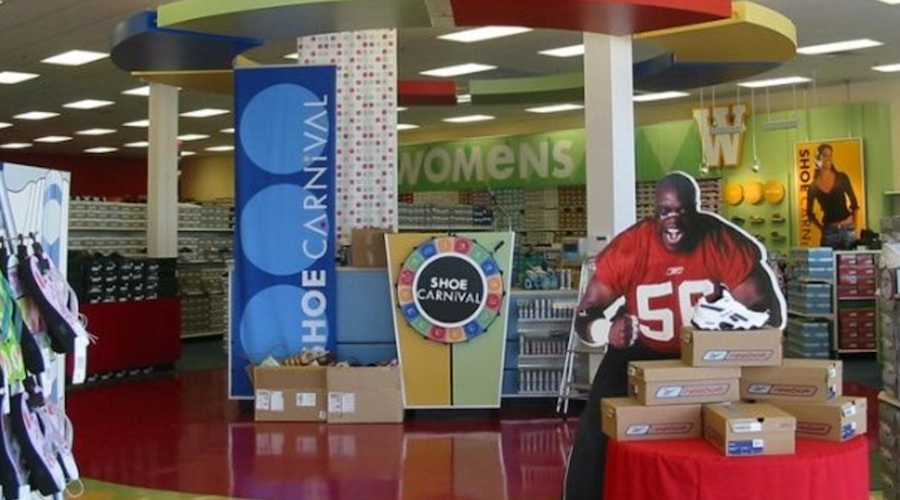Shoe Carnival, as expected, reported earnings and sales dipped in the first quarter as tax refund delays dragged down sales in February. But officials for the family shoe chain said sales picked up over the last three months and were optimistic about sales trends for the rest of the year.
Shares of Shoe Carnival were trading up $2.08, or 11.2 percent, to $20.71 in early afternoon trading Thursday.
“We are encouraged by the early positive trend we are experiencing so far in May,” said Cliff Sifford, president and CEO, on a conference call with analysts. “With the headwinds of a later tax refund season and a later Easter behind us, we look forward to a more normalized calendar as we navigate our way through the remainder of the year.”
On May 2, Shoe Carnival warned that delays in the mailing out of tax refund checks was largely responsible for a 3.9 percent drop in same-store sales in its first quarter. Consequently, the shoe chain slightly reduced its full-year guidance for sales and earnings.
Sales are expected to arrive in the range of $1.002 billion to $1.018 billion, with comparable store sales flat to down low single digits, and EPS in the range of $1.30 to $1.45. That compared to the company’s prior outlook for net sales of $1.028 billion to $1.040 billion, with comparable store sales flat to up low single digits and EPS between $1.45 to $1.54.
In the first quarter, net income declined 23.4 percent to $8.2 million, or 48 cents per share. Sales declined 2.7 percent to $253.4 million.
Gross margins decreased to 28.5 percent from 29 percent in the same period a year ago. Merchandise margins increased 0.3 percent due primarily to tighter inventory control and were offset by buying, distribution and occupancy expenses, which increased 0.8 percent as a percentage of sales versus the year-ago first quarter.
SG&A expense increased 1.1 percent to $58.9 million. As a percentage of sales, these expenses increased to 23.3 percent compared to 22.4 percent a year ago.
“Like many companies across the specialty retail industry, we had a challenging start to fiscal 2017,” said Sifford on the call. “We believe this was primarily due to the IRS decision to delay tax refund season until the end of February compared to mid-February last year.”
He said that historically, in conjunction with the timing of tax refunds, customers use the beginning of the year as a “second back-to-school sales period, where they replace the athletic footwear purchased in July and August.” This year, an escalation of sales occurred in the first few weeks of tax refund season but sales results never hit the peaks experienced in comparable prior year periods.
In addition, the later Easter selling season hurt sales because the holiday moved away from the timing of spring break.
The comp decline was due to a drop in February as March and April sales combined were up 1.4 percent on a comp basis. For the quarter, conversion was flat. Average dollars per transaction and units per transaction were up low single digits. These positive results were partially offset by a mid-single-digit decline in brick-and-mortar traffic.
Among categories, adult athletic was down low-single digits on a comp basis with increases coming from retro product, athleisure and canvas. For the combined March and April time period, athletic footwear was up mid-single digits on a comparable basis.
Women’s non-athletic comps were down high-single digits. Positive results seen in junior dress shoes, tailored casuals and sport sandals and canvas casuals were offset by a double-digit decline in boots and a high single-digit decline in sport casuals and traditional dress shoes. For March and April combined, women’s non-athletic was down mid-single digits on a comparable basis.
Men’s non-athletic comps were down mid-single digits. while men’s casuals posted a mid-single-digit increase. A double-digit decline was seen in men’s dress and a mid-single-digit decline in men’s boots. For March and April combined, non-athletic was flat on a comparable basis. Children’s shoes were down low single digits as increases in girl’s athletic, infants and kid’s casuals were not enough to overcome decreases in dress shoes, boots and sandals. For the combined March and April months, children’s shoes were up mid-single digits, driven primarily from a high single-digit increase in children’s athletic.
Shoe Carnival ended the quarter with inventory down one percent on a per-store basis. Said Sifford, “We are pleased with our product offerings, and our inventory is well positioned in the right categories for the second quarter.”
Regarding May, Sifford said sandals rebounded “fairly strong” after a disappointing first quarter and should continue to lift sales with its traditionally strongest sandals selling month in June.
Sifford also said the company expects the “positive athletic and athleisure trend happening in the footwear category will continue” and it has reallocated inventory dollars to the athletic and athleisure categories for the second half to take advantage of this trend.
Regarding boots, Shoe Carnival has completed its boot buys for fall and is “pleased with the product direction” but is planning the category “very conservatively” while preparing to chase trends should boots outperform.
Despite the ongoing sales momentum seen in May, Sifford said he expects the chain will be facing a more promotional environment in coming months with retailers going out of business and store closures in many of its markets. He mentioned that the closing of MC Sports has already pressured stores in some markets and expects to feel additional pressures in the months ahead with several department store operators closing doors. About 41 percent of its stores, or about 170, will be affected by at least one closing this year.
Sifford also indicated that the weakness in traffic is widespread and “reflective of what’s going on with brick-and-mortar stores.”
Photo courtesy Shoe Carnival
















